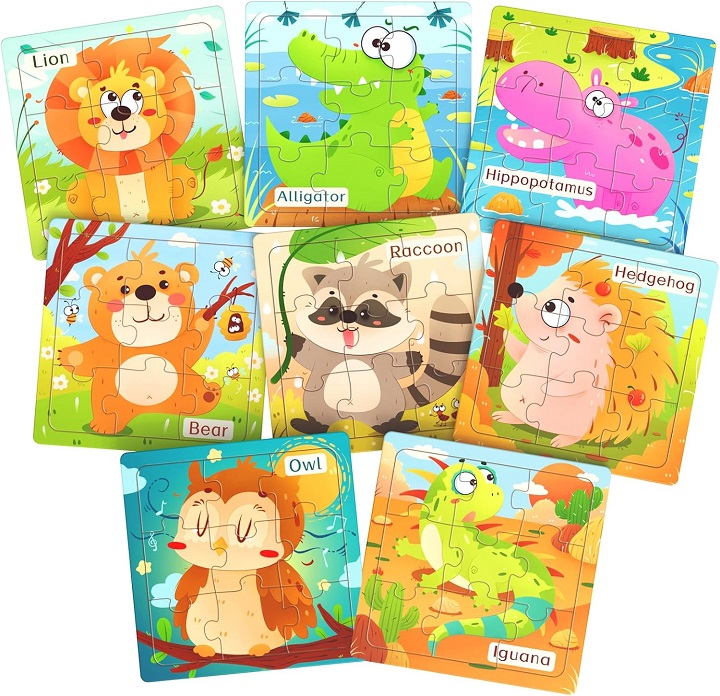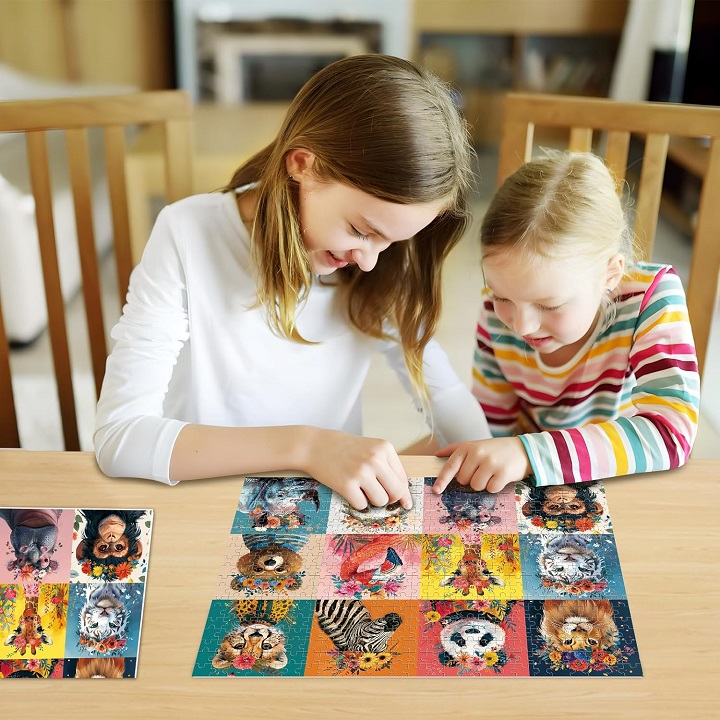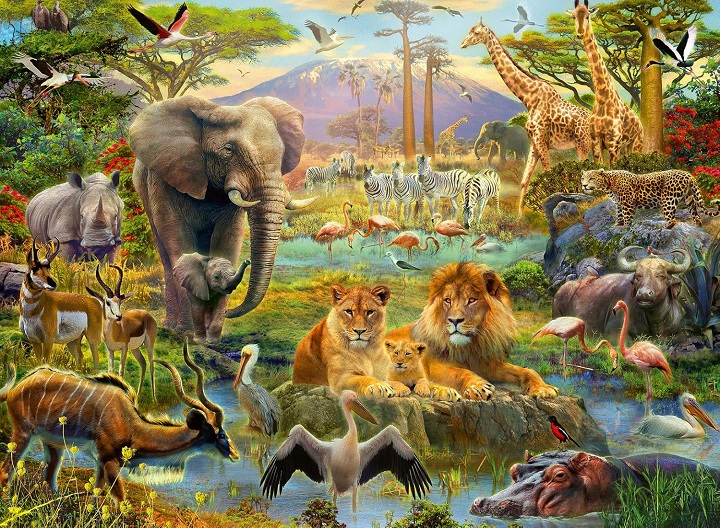Content Menu
● What Are Animal Puzzles?
● How Do Animal Puzzles Enhance Learning?
● Development of Problem-Solving Skills
● Improvement of Memory
● Fine Motor Skills and Hand-Eye Coordination
● Emotional and Social Benefits
● How Do Animal Puzzles Foster Creativity and Imagination?
● What Types of Animal Puzzles Are Available?
● How Can Animal Puzzles Be Used in Different Settings?
● What Role Do Animal Puzzles Play in Special Education?
● How Do Animal Puzzles Support Early Childhood Development?
● Why Are Animal Puzzles Important in a Digital Age?
● Can Animal Puzzles Help Promote Conservation Awareness?
● How Can Animal Puzzles Be Integrated Into Technology and Innovation?
● What Are Some Tips for Choosing the Right Animal Puzzle?
● Frequently Asked Questions About Animal Puzzles
● Conclusion
Animal puzzles have captured the interest of children and adults alike, offering a unique blend of entertainment, education, and cognitive development. But what exactly makes animal puzzles so captivating and beneficial? This comprehensive article explores the educational value, cognitive benefits, creative potential, and practical applications of animal puzzles, while addressing common questions and providing useful tips for maximizing their impact.

What Are Animal Puzzles?
Animal puzzles are jigsaw or wooden puzzles featuring images or shapes of animals from diverse habitats and species. These puzzles range from simple, chunky wooden puzzles designed for toddlers to intricate, detailed jigsaws that challenge adults. They often depict wildlife, domestic animals, or extinct creatures such as dinosaurs, providing a rich visual and tactile learning experience.
How Do Animal Puzzles Enhance Learning?
Animal puzzles serve as powerful educational tools by combining visual recognition with problem-solving skills. When players engage with these puzzles, they are not only assembling pieces but also absorbing information about animal shapes, colors, and characteristics.
Development of Problem-Solving Skills
Solving an animal puzzle requires critical thinking and spatial reasoning. Players must figure out how pieces fit together, enhancing cognitive abilities related to pattern recognition and logical thinking.
Improvement of Memory
Assembling puzzles helps improve memory by encouraging players to recall shapes, colors, and positions of pieces. This is especially beneficial for children learning about different animal species and their environments, reinforcing retention of new information.
Fine Motor Skills and Hand-Eye Coordination
Manipulating puzzle pieces improves dexterity and hand-eye coordination, particularly in young children. This physical engagement supports motor skill development alongside cognitive growth.
Emotional and Social Benefits
Working on puzzles can be a calming activity that reduces stress and promotes mindfulness. When done in groups or families, animal puzzles encourage communication, teamwork, and shared accomplishment.
How Do Animal Puzzles Foster Creativity and Imagination?
Beyond cognitive and motor skills, animal puzzles nurture creativity and imagination, especially in children. When assembling animal puzzles, children often invent stories and scenarios about the creatures, which enhances:
Storytelling Skills: Inventing adventures or habitats for animals supports language development and narrative abilities.
Artistic Expression: Inspired by the colors and shapes, children may create animal-themed drawings, paintings, or crafts.
Exploration and Curiosity: Puzzles spark questions about animal behavior, habitats, and conservation, encouraging further learning through books, videos, or museum visits.
This imaginative play is fundamental to holistic development and helps children emotionally connect with the natural world.

What Types of Animal Puzzles Are Available?
Animal puzzles come in various formats and materials, each offering distinct experiences:
Wooden Animal Puzzles: Durable and tactile, often designed for younger children. They may include pieces shaped like animals or traditional jigsaw pieces with animal images. Wooden puzzles are excellent for sensory learning and long-term use.
Jigsaw Puzzles: Available in a wide range of difficulty levels, jigsaw puzzles depict detailed scenes of animals in their natural habitats or close-up portraits. Suitable for all ages and skill levels.
Digital Animal Puzzles: Apps and online games offer interactive puzzles that include animal sounds and educational facts. These digital versions engage children with multimedia elements and adjustable difficulty.
How Can Animal Puzzles Be Used in Different Settings?
Animal puzzles are versatile tools that fit well in various environments:
At Home: Families use animal puzzles as bonding activities that spark curiosity about wildlife and nature.
In Schools: Teachers incorporate puzzles to complement lessons on biology, ecology, and geography, making learning hands-on and fun.
Wildlife Centers and Zoos: Visitors deepen their understanding of animals by assembling puzzles related to species they see, enhancing educational visits.
Healthcare Environments: Puzzles serve as therapeutic tools to reduce anxiety and improve focus, benefiting patients of all ages.
What Role Do Animal Puzzles Play in Special Education?
Animal puzzles are particularly beneficial in special education settings. For children with developmental delays, autism spectrum disorder (ASD), or sensory processing challenges, puzzles provide structured yet flexible activities tailored to individual needs.
Sensory Integration: Wooden puzzles with textured pieces offer tactile stimulation for children seeking sensory input.
Focus and Patience: The step-by-step nature of puzzle assembly encourages sustained attention and perseverance.
Language and Communication: Working on puzzles with educators or peers promotes interaction, vocabulary building, and social skills.
Confidence Building: Completing puzzles gives a sense of accomplishment, boosting self-esteem and motivation.
Educators and therapists often use animal puzzles as part of multi-sensory learning programs to support cognitive and emotional growth.

How Do Animal Puzzles Support Early Childhood Development?
During early childhood, the brain rapidly develops, and activities like animal puzzles have a profound impact:
Shape and Color Recognition: Puzzles help toddlers recognize shapes and colors, foundational skills for reading and math.
Cause and Effect Understanding: Figuring out how pieces fit teaches children about relationships and consequences.
Language Acquisition: Naming animals and discussing their traits during puzzle play enriches vocabulary and comprehension.
Social Skills: Working on puzzles with others promotes sharing, cooperation, and turn-taking.
Parents and caregivers can enhance these benefits by engaging in guided play, asking open-ended questions, and providing positive reinforcement.
Why Are Animal Puzzles Important in a Digital Age?
In today’s technology-driven world, animal puzzles offer a refreshing break from screens. They encourage tactile interaction and foster a sense of wonder about the natural world. This hands-on approach helps develop a lifelong passion for learning and environmental stewardship.
Can Animal Puzzles Help Promote Conservation Awareness?
Absolutely. Animal puzzles often serve as gateways to understanding biodiversity and the importance of protecting wildlife:
Highlighting Endangered Species: Many puzzles feature threatened or endangered animals, raising awareness about their plight.
Teaching Ecosystem Interactions: Puzzles depicting animals in their habitats illustrate ecosystem interconnectedness.
Inspiring Action: Learning about animals through puzzles can motivate players to support conservation efforts through donations, advocacy, or lifestyle changes.
Supporting Environmental Curriculum: Educators use puzzles as part of lessons on sustainability and environmental responsibility.
By connecting players emotionally and intellectually to animals, puzzles foster a sense of stewardship for the planet.
How Can Animal Puzzles Be Integrated Into Technology and Innovation?
While traditional puzzles are timeless, technology has expanded how animal puzzles can be experienced:
Augmented Reality (AR) Puzzles: Some puzzles come with AR apps that bring animals to life with 3D animations and interactive content, enhancing engagement and learning.
Customizable Puzzles: Digital platforms allow users to create puzzles from their own animal photos or drawings, personalizing the experience.
Educational Games: Combining puzzles with quizzes and challenges deepens knowledge about animal biology and conservation.
Accessibility Features: Digital puzzles can be adapted for players with disabilities, offering adjustable difficulty and assistive tools.
These innovations complement traditional puzzles, making animal learning more immersive and accessible.

What Are Some Tips for Choosing the Right Animal Puzzle?
Selecting an appropriate animal puzzle depends on the player’s age, interests, and skill level. Consider the following:
Age Appropriateness: Choose puzzles with larger, fewer pieces for younger children and more complex puzzles for older kids and adults.
Interest Alignment: Pick puzzles featuring animals the player loves or is curious about to increase motivation.
Material Quality: Durable materials like wood or sturdy cardboard ensure longevity and safety.
Educational Content: Some puzzles include facts or maps that add an extra layer of learning.
Challenge Level: Gradually increase difficulty to keep the experience rewarding and prevent frustration.
By considering these factors, parents and educators can maximize educational and entertainment value.
Frequently Asked Questions About Animal Puzzles
Q1: At what age can children start playing with animal puzzles?
A1: Simple wooden animal puzzles with large pieces are suitable for toddlers as young as one year old. More complex jigsaw puzzles can be introduced as children develop better motor and cognitive skills.
Q2: How do animal puzzles help with memory improvement?
A2: By repeatedly handling pieces and recalling their shapes and images, players reinforce their ability to remember details, which translates into better retention of animal facts and visual information.
Q3: Can adults benefit from animal puzzles?
A3: Yes, adults enjoy animal puzzles for relaxation, mental stimulation, and as a way to connect with nature through detailed and artistic representations of animals.
Q4: Are digital animal puzzles as effective as physical ones?
A4: Digital puzzles add interactive elements like sounds and animations, which can enhance engagement and learning, especially for young children. However, physical puzzles provide tactile benefits and reduce screen time.
Q5: How do animal puzzles promote environmental awareness?
A5: By learning about different species and their habitats through puzzles, players develop empathy and understanding of wildlife, inspiring conservation efforts and respect for nature.
Q6: How long does it typically take to complete an animal puzzle?
A6: Completion time varies widely depending on the puzzle’s size and complexity, ranging from a few minutes for simple toddler puzzles to several hours or days for large, intricate jigsaws.
Q7: Are animal puzzles suitable for group activities?
A7: Yes, animal puzzles encourage collaboration and communication, making them excellent for family time, classrooms, and social gatherings.
Q8: Can animal puzzles be used to teach scientific concepts?
A8: Definitely. They can illustrate concepts like animal classification, habitats, food chains, and adaptation in an engaging, hands-on way.
Q9: What are some creative ways to use completed animal puzzles?
A9: Completed puzzles can be framed as artwork, used for storytelling sessions, or serve as inspiration for craft projects and educational displays.
Q10: How do animal puzzles compare to other educational toys?
A10: Animal puzzles uniquely combine visual, tactile, and cognitive learning, offering a multi-dimensional educational experience that few other toys provide.

Conclusion
Animal puzzles are more than just games; they are powerful tools that stimulate the mind, nurture creativity, and foster a deep connection with the animal world. By enhancing cognitive skills, supporting emotional development, and promoting environmental awareness, these puzzles serve learners of all ages in diverse settings. Whether traditional or digital, simple or complex, animal puzzles invite us to explore, imagine, and appreciate the rich tapestry of life on Earth.


































